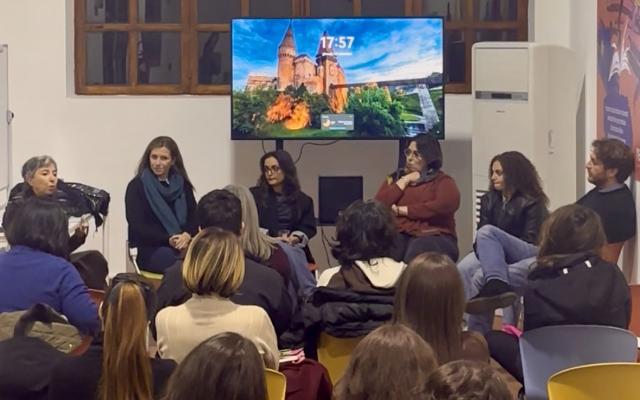7 min.
According to the most recent data published by theFondazione Leone Moressa, in 2010, 673, 800 foreigners were enrolled in Italian schools. This represents nearly 7,5% of all students, a net increase of 7% over the last year an 81.1% compared to 2005. Amongst fifteen year olds, the majority is first generation and amongst them, more than half arrived in Italy less than six years ago. The Provinces of Milan, Rome, Turin and Brescia have the most foreign students.
Another recently published work is Vinicio Ongini’s Noi domani. Un viaggio nella scuola multiculturale (Us Tomorrow. A Voyage through Multicultural Schooling Laterza, 2011).
Prof. Tullio De Mauro has written the preface to the book:
“A genial Italian architect and urban designer, Luigi Piccinato, used to repeat a motto to soften the contrast between city and countryside: “All cities were born in the country.” When we speak of aliens, foreigners, migrants, mestizos, we should remembers that we are all aliens and foreigners to some one. We all have the DNA of someone who came from outside, a foreigner, to where we now are. We are all mestizos. Just trace your family history back in time through a few generations.
The child solemnly says: “At home, we do it like this,” referring to a common action, but she is also attentive and curious about the unknown. According to Thucydides, in his famous speech, Pericles exhorted Athenians to be proud citizens of a city always open to those coming from outside. Clearly, this represents the ambivalence that we all demonstrate. We are who we are because others, even very different from us, made us and do as we do. It’s true of individuals and it’s true for large human groups.
The thousands of languages of mankind reflect this ambivalence. Foreigners were to the Latins both hospes and hostis - host and enemy – two words that share the same etymology. The Greeks considered foreigners ekhthròs and xénos (external), but gifts were referred to as xénia and were typically reserved for foreigners. In Ancient Rome, those who lived outside the city walls were referred to as exquillini as opposed to the inquillini who lived within. Then, the walls were extended and the Esquilino became one of the sacred seven hills. Indeed, the very origins of Rome are based on mestizos. The Italian word ospite – meaning both host and guest – still contains the ancient etymological ambivalence that is also present in other languages. In Latin, it appears that hospes were first the "hosts who welcomed foreign guests" and only later also came to mean guest.
If migrations hadn’t deeply affected the history of mankind, we would still be living on trees in the African savannah, uncertain about whether to climb down and walk upright on the ground. A few million years ago, others made that choice for us. And since then, subsequent generations of hominids, who had become bipeds, left Africa in a series of migrations to spread throughout all the continents. When fire had already been mastered throughout Asia and Europe, sophisticated tool making techniques had been developed and sign language was employed to teach and communicate, Homo Sapiens Sapiens, from which we are honoured to descend, decided – about 100,000 years ago - to enter Asia and Europe and push towards the American continent. And they conserved their ambivalence. They formed different groups in the quest to survive and each new group formed from the others was open to newcomers from yet other groups. They developed different languages to communicate amongst themselves, but each language was and is the key to understand each other, each language derived richness of expression and new meaning from the others.
This natural story of migration is embedded in our species and the history of which we are all a part. We should never forget this. In Europe, there are those that try to forget and make us forget this, at times. There are those who nourish the fear of others and exploit this to win a few easy votes. This even occurs in those countries that were and are vastly hospitable civilisations: from France to the Scandinavian countries. It happens in Italy. However, in general, it does not happen in our schools.
In truth, the electoral exploitation of fear is a recently novel issue in Italy. Sergio Mattarella, the Minister of Education of the sixth Andreotti government (1989-1991), addressing the fact that Italy had become a land of immigration, emanated a bill addressing schools and requiring them to organize the reception of the children of immigrant families. Schools were ready and still are, even if no one remembers that important step. Starting in the early ‘90s and in some cases a few years earlier, Universities – Pavia, the University for Foreigners in Siena, Bergamo, Venice (Università Ca’ Foscari), Naples, Roma Tre, Palermo and the Centre for Multilingualism in Udine, just to mention the most active - began to systematically study the demographic, sociological, linguistic and educational aspects of the growing immigration phenomenon.
Vinicio Ongini has documented the issues, failures and successes of multicultural schooling in Italy. Those who feel overwhelmed by the news of xenophobia presented by the media should follow his voyage, read his concrete and suggestive case studies.
It’s not the only aspect in which schools do not mechanically reflect the trends and feelings of society. In other words, if it reflects society, it is also capable of filtering and eliminating its worst elements. Take reading as an example: since the Sixties, we have followed the (slow) progress of the tendency to read in our country. Each new survey shows that children and the younger generations read far more than the elder generations. The high percentages (nearly European-level) of extra-scholastic books ready by the young, decline amongst those adults who are older than thirty. This positive data reveals the educational efforts produced by schools. Or look at reading comprehension. The data periodically published by the OECD on the reading comprehension of fifteen year olds is always big news, but also raise silliness, including that of some ministers. Forty percent of kids have issues with reading comprehension. This will have to improve. However, adults with similar issues (18-65) are not 40%. In fact, the last international comparative survey indicates that in this bracket the figure is more than 80%. This is more than double the percentage of students. If schools were to mechanically register the lack of competence of illiterate adults, the OECD data should indicate that 80% of students have issues, too. The 40% difference shows the great effort that schools are putting into action and will have to continue to do. This effort could be increased if we were to invest more in schooling: more in terms of funding and more in terms of attention, following the example of Vinicio Ongini.
If there are any reproaches to be made about schools, it’s that they are not always aware of what they have done, can do and do for the entire country. Amongst its other merits, Ongini's book can help and stimulate the right type of pride in our public schools."



